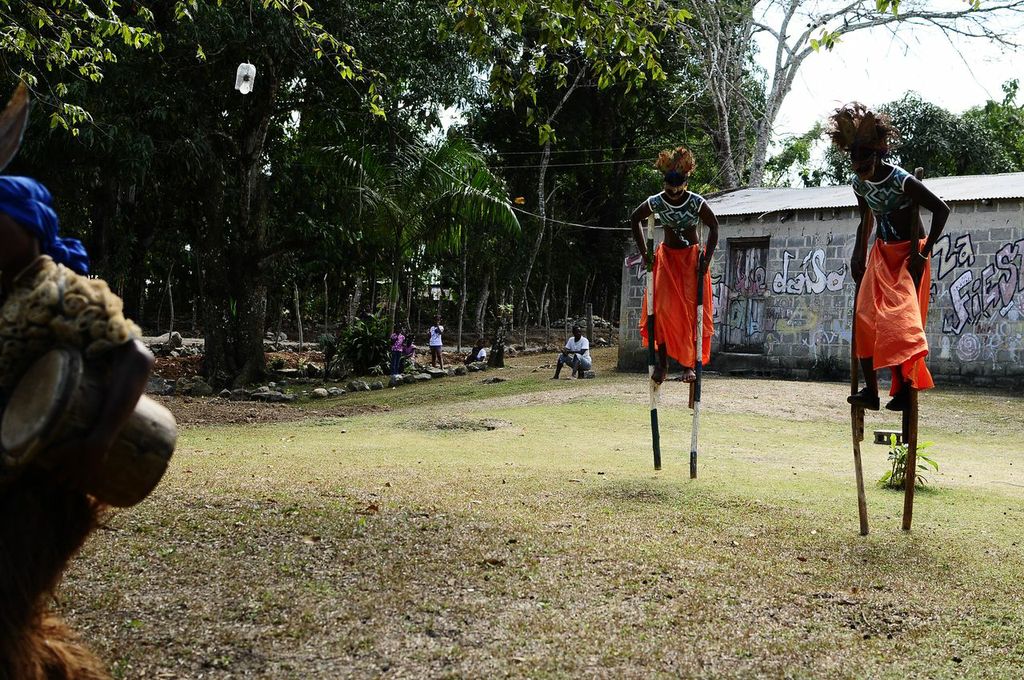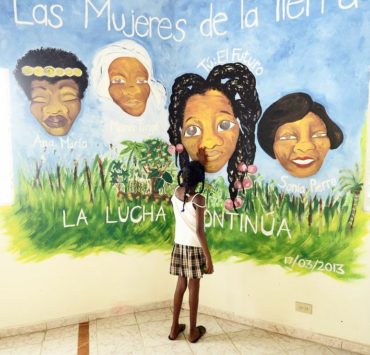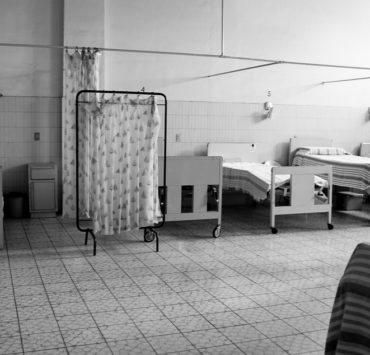
Iya Abebbe Oshun arranged a dress on a wooden statue that represents her spirit guide, Francisca. She pulled at the seams of fabric to cover the bottom.
“Can you explain to the collective why, in an îlé devoted to the Yoruba religion and to black memory, we have a white Jesus on our front porch?” Iya Abebbe Oshun placed peacock feathers in Francisca’s ears.
“It’s a huge deal to be able to maintain this religion in such a fundamentalist Catholic country. ¿Tú crees que es facil?”
I shook my head. I know it isn’t easy.
“People call me a witch, and they come to my door asking me to amarrar their husbands, or to get them a job. I’m not a witch. I’m a priestess of Oshun.”
I was at Iya Abebbe Oshun’s house as part of my planning work for the Transnational Black Feminist Retreat. We were going to start the retreat by visiting the Ile. She hosted the Welcome Dinner and Conversation. Aside from being an Oshun priestess for over 30 years, Iya Abebbe Oshun is also a renowned journalist. She is finishing a book she has put together on black goddesses in the Americas. It’s meant to be a resource for people working in Afro-Diasporic traditions. For these reasons, I decided to ask her if she would host the Welcome Dinner. And she had agreed. But she was concerned about how people would perceive the painting of a white Jesus on her porch.
“We’re going to moyumbar the egun. Because even though this is Oshun’s house and you have Yoruba initiates coming here, the idea of all of these people of African descent – from different places – coming together, speaks to the egun, the ancestor spirits. So, we are going to greet the egun,“
Iya Abebbe Oshun sat at the table with me and looked me straight in the eye.
“So Ana, what do you want me to talk about?”
“Well, your work.”
“This is my work. My work is calling the spirits. My work is honoring Oshun.”
“Right. And could you also talk about your work on researching black goddesses in the Americas, and your work as a journalist in Haiti, the Congo and here?”
“Ok.”
Two weeks later, Iya Abebbe Oshun greeted me and a crew of eleven artist-activist-scholars in her full Oshun regalia. She led us to the back of the îlé where she had set up a seven foot ancestor altar. Francisca, the statue that represented her guardian spirit was dressed from her crown down to the ground, and at her feet there were baskets upon baskets of fruits and flowers. A bowl of water with rose petals sat in the middle, waiting for us. Manny, an Oba crowned with Obatala, waited for us at the altar. As we formed a circle in front of them, Iya Abebbe Oshun began.
“We are the descendents of Africans who were brought to this continent for a purpose. And that purpose was to maintain our traditions. We’re here from different lands, and we are all the products of our ancestors. For this reason, today, as we welcome you to this island – Santo Domingo – this island where so many of our ancestors passed through, we welcome you by calling in the spirits. We believe in the spirits because we are a tradition oriented to the ancestors, and our ancestors are spirits who help us and guide us. This spirit, embodied here, is Francisca. And Manny will lead us in the prayer honoring the spirits, the ancestors.”
Manny introduced himself and explained how he came to the prayer he was sharing with us, and what it meant. He recited it in Cuban Yoruba, the language of the religion of Osha. I watched as some of my peers wriggled uncomfortably. Many of them paid close attention and stayed grounded, but I knew this was a new experience for the majority of folks. And that for some of them even scary. I was grateful that they trusted me enough to stay.
After the prayer, Manny invited us to take the water from the bowl and cleanse ourselves. Iya Abebbe Oshun piped up,
“So that there are flowers, and not stones, in your path.”
Almost everyone took a moment to cleanse themselves. I did, too. Then Manny led us inside.
We sat in a circle, Oshun’s altar behind Manny. Myself next to him so that I could translate. He began with a pataki, a moral narrative.
“When Olofi first created humans, they were androgynous beings. These beings were both and neither male and female. The gods, jealous of Olofi’s creation, distorted these beings until they were destroyed. And so then it was that Olofi sent Obatala to create new beings, and these new beings were created different from each other: one as a man, and the other as a woman. But the men retained their areola and this was to remind them that they had come from women.”
Though more elegantly and eloquently spoken than what I share here, this was the story that we were going to discuss. Manny opened the floor for questions. To break the ice, I launched the first question.
“What about those people who are either both men and women, still or are neither, still. What’s their place in the creation of the world?”
Manny laughed.
“I knew you were going to ask me that question. And I am prepared!”
Everyone laughed with us. I was thinking about all of my transgender friends. And about myself and other queer people, who challenge the boundaries and ideas of what is “man” or “woman”.
“There are still some of those androgynous beings that continue to exist. And then there are the Ala’kua and the Adodi – those who are different and only stay with their own gender. All of these beings, these seres humanos, are protected by Inle, the healer. They go to their own heaven. That is why so many Adodi and Ala’kua are healers, because that’s how it’s written.”
At the île, participants wanted to know why he, who had been a Catholic priest, was now an Oba in Osha.
“I loved my Catholic faith. But, when I became ill, it is Obatala who saved my life. And my madrina, under the guidance of Francisca and her divine mother Oshun.” He responded.
Someone else asked whether both men and women could practice and enact all aspects and rites of the religion, or whether there were limitations.
“Women generally don’t make offerings. That is in the realm of men. But other than that, all people can become practitioners within the religion.”
“But there are some things men can’t do, either.”
“Yes. There are some ceremonial rites that men cannot do.”
“And so, what about the Adodi and Ala’kua?”
“There are some things that they can’t do, either. But not because they are bad, but because their power is elsewhere.”
The conversation wrapped up and Iya Abebbe Oshun invited us to greet Oshun. Some did, some didn’t. We wandered into the backyard, where a huge meal of morro, yucca root, bacalao (codfish), stewed chicken, banana, corn cake and avocado, had been prepared for us.
“This is the food that sustained us in the slave quarters, and that continues to sustain us now,” said, Iya Abebbe Oshun.
As I served myself a plate I digested what was actually happening; I was hosting eleven black feminist artist-activist-scholars in the Dominican Republic for a week. And we had started with the ancestors.
What led me to incorporate a ceremonial/spiritual aspect to the work of meeting with black feminist activists, artists and scholars here in the D.R.? I could say a spirit I spoke to suggested that those participating in this retreat were coming to do spiritual work. But in keeping with the works of scholars like Luisa Teish and Jacqui M. Alexander, I must substantiate this So, I will say that the space for interrogating spiritual work and the place of spirit opens up epistemological possibilities in the realm of black feminist scholarship that might otherwise not exist.
Throughout the week, many things happened for the participants – including spirit possession and the delivery of spiritual messages by and between participants. These occurrences were real in that they presented as illness, or as disruptions, or as communications in Kreyol, English and Spanish that provoked new realizations and epiphanies, and sometimes, tears. These spiritual provocations caused emotional shifts and generated intellectual questions that in other contexts, may have been impossible to ask. For some participants, it was the end of solitude. And for some, it was awakening to how spiritual sustenance could sustain them in their work over the long haul. And yet for others, it was coming to terms with their preconceived dismissive or shameful notions of Afro-Diasporic religious practices.
By calling in the ancestors, we created a lens through which we could develop intellectual and affective analysis of what we were experiencing. On Monday morning, the day after arriving in the D.R. and our visit to the île, we went to the first plantation of the Americas. The site, according to the Dominican black feminist historian who spoke to us there, Fatima Portorreal, was where the Spaniards developed their industrial economic model and their modes of torture. We touched the walls of the sugar cane factory where some of our ancestors had labored, in denigrating conditions, to maintain ovens and stir molasses. And we also learned about Ana Maria, the name given to the black female leader who led a rebellion against the Spanish colonials in 1796, and established a maroon communal government. She is memorialized on a mural at the site. Not more than a month after establishing her government, she, along with six other maroon leaders, were hanged and quartered, her head perched at the entrance of the city of Santo Domingo as a warning. The site was so significant, that when Toussaint crossed the island, he spoke at the Ingenio Boca de Nigua, and referred to its rebellion and its leaders as important models of black sovereignty.[1]
There were many moments of teaching and learning. But Manny’s call to the ancestors was everpresent and facilitated our asking: What about the remains of all the people who had sweat and labored on this land? Where were their remains?
Fatima responded, “The only African remains we have found were discovered under the church at the ruins in the colonial city. And when they were announced, the Cardenal had the graves cemented over. But we don’t know whether African laborers were thrown into the ocean, or burned at the pyre. Archaeologists have yet to find one African burial ground from the colonial period.”
So if they weren’t buried, if we cannot find their remains, “then how can they rest, and by association, how can we rest until they do?” In other words, the question of remains, of the honoring of those who passed before us becomes a question of work – and of moral, ethical and intellectual imperatives.
The very last day of the retreat, we went to the beach. The trip’s original intention had been to meet and talk to sex workers, but the heavy emotional, intellectual and spiritual work that had taken place over the week left us exhausted and overwhelmed. And so, I decided that going to the beach together would give us the informal time necessary to enjoy each others’ company and cement some of our connections before everyone headed home.
However our trip to the beach actually cemented for us the reality that our black women’s bodies are embattled, and most explicitly in the spaces of European leisure. One of our colleagues walked up to the water and was approached by a white Italian tourist. The rest of us watched, fully knowing she knew how to handle herself. He went so far as to offer money to her, setting up his chair to stare at her and approaching her again after she went back into the water. The tourist ignored the black men in the group, and the black restaurant owner – all who told him to leave us alone.
“What bothered me so much wasn’t only that he harassed our friend, but that he ignored the men in the group. That he didn’t recognize nor validate their masculinity.” One of us said and we all deliberated that if there was a white man in the group with us, the likelihood that this man would have respected boundaries was greater.
The incident came to a head when we were getting ready to leave, and he circled down on our colleague. Other women surrounded her and we ushered her to safety. But everyone was shaken. Who did this man think he is? And how dare he violate our space, and our friend’s person? Our first world sensibilities were shaken. After all, we were in a circle of scholars, artists and activists. The assumption that our work could shield us from this kind of violence was always present. But, our class, our difference did not protect us. He had started his conversation with her, by asking her if she was Dominican. He saw a group of black women – of various shades, tones, shapes and ages – and two black men and assumed we were on the beach for sex work. He saw a young dark-skinned black woman and assumed she was Dominican, and therefore, for sale. He saw a Dominican and assumed she would sleep with him. Because he was European. Because he was a man. Because she was for sale. And when we didn’t behave as he expected, his violence escalated. And still, he tried to buy her. He stalked our colleague, without regard for anyone, and with the entitlement of someone who had done this many times before – and with other black women; with the certainty that she – like all black women – was available for his consumption. Our Saturday at the beach had ended on a bitter note.
We climbed into the van and rode in silence. There was a carnival going on in the streets. I asked if someone wanted to stop, but nobody did. We were demoralized, shocked and hurt, individually and collectively. But I didn’t want to assume what people needed in that moment. I searched the streets for a police officer. I found one who half ignored me as I told him there was a European man on the beach going after women. The police officer laughed. My complaint was out of place, ridiculous, especially in a van full of black women. He waved me on. I continued, further demoralized. And then we stopped at an isolated beach, piling out of the van and clambering through the sand.
We got to the ocean’s edge. The wind pushed against us. Alai Chemi – the Yemanya priestess among us – led us in another form of [mo]yuba. We stood in a circle, our feet in the ocean, spraying ocean water on each other, cleansing ourselves of all the hurt, the loss, the pain, the violation and as Dionne Brand says, “the virtuosity and despair”[2] of these bodies of the African Diaspora. We offered fruit to the ocean, and everyone cried. There were solid, real tears – tears that had been gathered over the course of the week, and now found their space to appear. We could not undo what had just been done. We could not put our dead to rest. But we could heal ourselves and each other with momentary laughter. We could honor the dead with each tear, each stretch of hand in air. I stood back and looked at these incredible people, their feet in the water, their various tones of brown skin resplendent in the setting sun, our collective blackness, our relative queerness vibrating off our skins, and I thought:
We, too, have our place in heaven.
And heaven, in African Diasporic theologies, is right here.
There was no need to explain white Jesus.
–Ana-Maurine Lara, 2014
References
[1] Presentation and guided tour with Fatima Portorreal, historical anthropologist and professor, INTEC; nationally known black feminist and indigenous rights activist.
[2] Brand, Dionne (2001) A Map to the Door of No Return. Doubleday Canada, p. 27.

Ana-Maurine Lara's poetry and short fiction has appeared in several literary journals including Blithe House Quarterly, The Encyclopedia Project, Sable LitMag and Torch Magazine. She has received awards from the Barbara Deming Memorial Fund, Puffin Foundation, the Brooklyn Arts Council and PEN Northwest. Her debut novel, Erzulie's Skirt, was selected as a Lambda Literary finalist in 2006; her second (unpublished) novel, Anacaona's Daughter, won Third Place Prize in the National Latino/Chicano Literary Prizes. Ana-Maurine is a Cave Canem Fellow and a member of The Austin Project, a collaborative workshop between artists, activists and scholars out of UT-Austin. She coordinates an oral history project documenting the lives of lesbian, gay, bisexual, transgender artists titled: We are the Magicians, the Path Breakers and the Dream Makers (http://themagicmakers.blogspot.com/) and is also co-author of bustingbinaries.com: a website dedicated to addressing binary thinking in U.S. based social justice movements. She is a graduate of Harvard University. Currently she resides in Austin, TX. Check out her website www.zorashorse.com and Blogspot: http://zorashorse.blogspot.com/ Visit: http://www.myspace.com/zorashorse To view a short reading from debut novel: Erzulie's Skirt - A Novel







